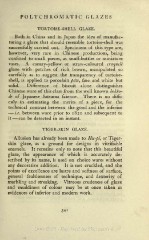Page 419 - Oriental Series Japan and China, Brinkly
P. 419
POLYCHROMATIC GLAZES
TORTOISE-SHELL GLAZE.
Both in China and in Japan the idea of manufac-
turing a glaze that should resemble tortoise-shell was
successfully carried out. Specimens of this type are,
however, very rare in Chinese productions, being
confined to small pieces, as snuff-bottles or miniature
Avases.
canary-yellow or straw-coloured craquele
glaze with patches of rich brown, manipulated so
carefully as to suggest the transparency of tortoise-
shell, is applied to porcelain pdtey fine and white but
solid. Difference of biscuit alone distinguishes
Chinese ware of this class from the well known bekko-
de of Japanese Satsuma faience. There is no diffi-
culy in estimating the merits of a piece, for the
technical contrast between the good and the inferior
i.e. between ware prior to 1820 and subsequent to
it can be detected in an instant.
TIGER-SKIN GLAZE.
Allusion has already been made to Hu-pi, or Tiger-
skin glaze, as a ground for designs in vitrifiable
enamels. It remains only to note that this beautiful
glaze, the appearance of which is accurately de-
scribed by its name, is used on choice wares without
any decorative addition. It is not crackled, and the
points of excellence are lustre and softness of surface,
general faultlessness of technique, and dexterity of
marbling and streaking. Vitreous crudeness of glaze
and muddiness of colour may be at once taken as
evidences of inferior and modern work.

